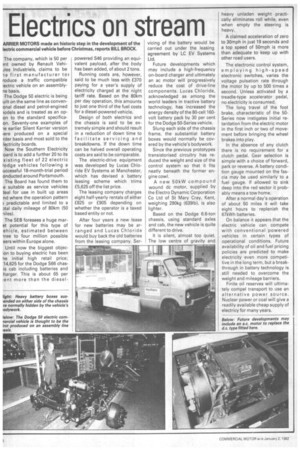Bents on stream
Page 6

If you've noticed an error in this article please click here to report it so we can fix it.
ARRIER MOTORS made an historic step in the development of the lectric commercial vehicle before Christmas, reports BILL BROCK.
The company, which is 50 per .int owned by Renault Vehiales lndustriels, claims to be le first manufacturer tor roduce a traffic compatible lectric vehicle on an assemblyne basis.
The Dodge 50 electric is being uilt on the same line as conven°nal diesel and petrokengined iodels and is treated as an opon to the standard specificaon. Seventy-one examples of le earlier Silent Karrier version sere produced on a special rder basis and most sold to the le,ctricity boards.
Now the Southern Electricity loard is to add a further 20 to its xisting fleet of 22 electric lodge vehicles following a uccessful 18-month-trial period onducted around Portsmouth. The Board has found them to ie suitable as service vehicles Jeal for use in built up areas nd where the operation pattern 5 predictable and limited to a atal daily mileage of 80km (50 nil es).
The SEB foresees a huge maret potential for this type of elide, estimated between iree to four million possible sers within Europe alone.
Until now the biggest objecion to buying electric has been he initial high retail price; :14,625 for the Dodge S66 chasis cab including batteries and :harger. This is about 65 per :ent more than the diesel powered 546 providing an equivalent payload, after the body has been added, of about 2 tons.
Running costs are, however, said to be much less with £370 paying for a year's supply of electricity charged at the night tariff rate. Based on the 80km per day operation, this amounts to just one third of the fuel costs for a diesel-powered vehicle.
Design of both electrics and the chassis is said to be extremely simple and should result in a reduction of down time to facilitate servicing and breakdowns. lf the down time can be halved overall operating costs are said to be comparable.
The electric-drive equipment was developed by Lucas Chloride EV Systems at Manchester, which has devised a battery leasing scheme which trims £5,625 off the list price.
The leasing company charges eight half-yearly rentals of either E825 or £905 depending on whether the operator is a taxed based entity or not.
After four years a new lease for new batteries may be arranged and Lucas Chloride would buy back the old batteries from the leasing company. Ser
vicing of the battery would be carried out under the leasing agreement by LC EV Systems Ltd.
Future developments which may include a high-frequency on-board charger and ultimately an ac motor will progressively reduce the cost of drive-line components. Lucas Chloride, acknowledged as among the world leaders in tractive battery technology, has increased the energy density of the 80-cell 160volt battery pack by 30 per cent for the Dodge 50-Series vehicle.
Slung each side of the chassis frame, the substantial battery boxes would normally be covered by the vehicle's bodywork.
Since the previous prototypes transistorised circuitry has reduced the weight and size of the control system so that it fits neatly beneath the former' engine cowl.
A new 50 kW compound wound dc motor, supplied by the Electra Dynamic Corporation Co Ltd of St Mary Cray, Kent, weighing 290kg (6391b), is also lighter.
Based on the Dodge 6.6-ton chassis, using standard axles and cab, the new vehicle is quite different to drive.
It is silent, almost too quiet. The low centre of gravity and The electronic control system, employing high-speed electronic switches, varies the voltage pulsation rate through the motor by up to 500 times a second. Unless activated by a treadle-type accelerator pedal, no electricity is consumed.
The long travel of the foot brake, characteristic of the 50Series now instigates initial retardation from the electric motor in the first inch or two of movement before bringing the wheel brakes into play.
In the absence of any clutch there is no requirement for a clutch pedal. Gear selection is simple with a choice of forward, park or reverse. A battery condition gauge mounted on the fascia may be used similarly to a fuel gauge. If allowed to sink deep into the red sector it probably means a tow home.
After a normal day's operation of about 50 miles it will take eight hours to replenish the 67kWh batteries.
On balance it appears that the electric vehicle can compete with conventional powered . vehicles in certain types of operational conditions. Future availability of oil and fuel pricing policies are predicted to make electricity even more competitive in the long term, but a breakthrough in battery technology is still needed to overcome the weight and mileage barriers.
Finite oil reserves will ultimately compel transport to use an alternative power source. Nuclear power or coal will give a readily available cheap supply of electricy for many years.














































